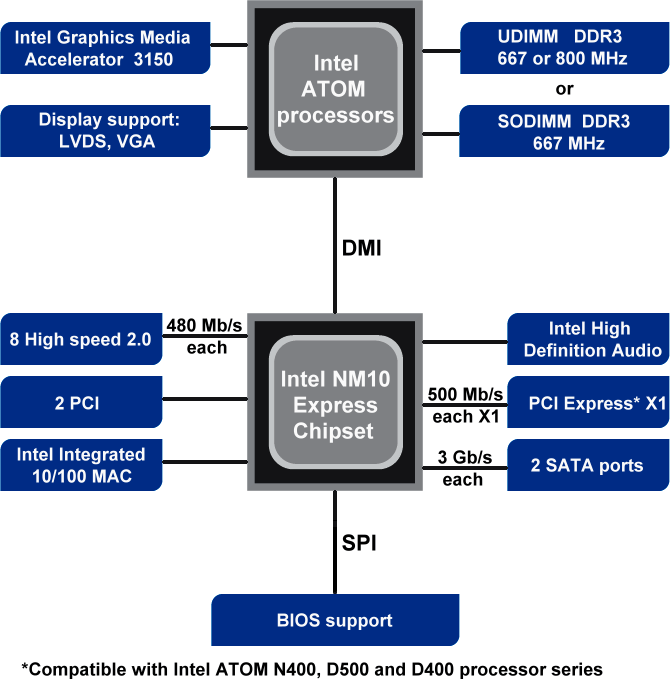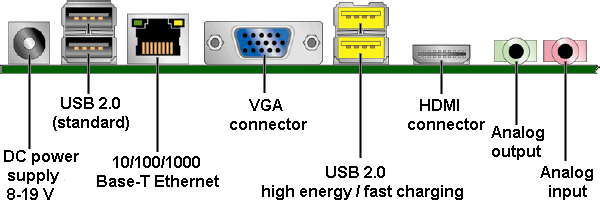Mini-ITX Motherboard - Chipset NM10 |
Reducing the size of elementary transistors is the main factor creating weaker microprocessor called ATOM. Generation of Intel Atom microprocessors, the original idea (as the Q57 chipset), primarily distinguishes the collection and interlinking processing, multimedia (video accelerator), and graphics capabilities in a single chip by physical and logical basis, and fully completed in 32 nm technology, as shown in the next set of pictures.
 |
|
| Figure 3.5.81 Microprocessor ATOM. |
Application of 32 nm technology and its improvement enables smaller physical size of transistors, which means that it can integrate more logic circuits on silicon plate, but also to increase the functionality of such a microprocessor itself, and compared to the previous generation of microprocessors, their recent release includes advanced technology.
The following example shows one Mini-ITX motherboard with Atom processor which belongs to the the top offer.
Example XVI
Effective support multiple microprocessor cores and integrated graphics system of the family of Intel 'Sandy Bridge' for undemanding home and office use with the motherboard chipset Intel NM10 for microprocessors type 'ATOM', manufactured in 32 nm technology with integrated processor and graphics system, which uses Micro-FCBGA assembly.

|
| Figure* 3.5.82 Block scheme of Intel NM10 chipset / Intel-DN2800MT. ( + / - ) |
NM10 chipset features support for an additional graphics card, and in this example it is possible to use graphic card inserted into PCI Express x1 slot. NM10 chipset allows direct 'overclocking' the BIOS-level, and the BIOS is hidden beneath the battery. Such a unified concept allows you to create cheaper and smaller computer systems, the smaller motherboards with minimal upgrade possibilities, enough for one office as accounting firms say, where there is no need for powerful hardware resources. If there is a need for FDD device, expansion is easy to use FDD device that uses USB as the communication interface. Diagnostics of the POST process is done BEEP code which is transmitted through the audio system connections. Animated signs describe the purpose of each component and have the sort order of convergent activation of individual devices after switching computers. The following table describes the structure and capabilities motherboard shown in Figure 3.5.38b:
| Form Factor | Mini-ITX (170.18 mm × 170.18 mm) |
| BIOS with support for SMBIOS |
8 Mb BIOS in the Serial Peripheral Interface (SPI) Flash EEPROM. Support for Advanced Configuration and Power Interface (ACPI), Plug and Play (PnP), and System Management BIOS (SMBIOS). |
| Processor 1.86 GHz with Intel® 64-bit architecture; |
Dual-Core Intel® Atom™ Processor N2800. Integrated graphics and integrated memory controller. Hyper-Threading technology; 2 cores, 4 threads. 2 × 512 MB L2 cache. Instruction Set Extensions: SSE2, SSE3, SSSE3 |
| Processor TDP | Maximum 6.5 W |
| Processor socket | FCBGA 559 (Flip Chip Ball Grid Array) |
| Chipset | Intel® NM10 Express Chipset; 45 nm technology |
| Chipset TDP | 2.1 W |
| Clock Generator | Silego* SLG505YC264CT PLL (Phase-Locked Loop) with crystal |
| Legacy I/O Control | Nuvoton* W83677DHG |
| Integrated Graphics | GMA-3150 graphics; DirectX 9c. Digital displays (High Definition Multimedia Interface* HDMI), Analog displays (VGA), Flat panel displays (LVDS & eDP). |
| External Graphics | One PCI Express 1.0a x1 graphics add-in card connector |
| Memory - Max. Supported | 4 GB - 2 × Small Outline Dual Inline Memory Module (SO-DIMM) |
| Memory Frequency | Non-ECC DDR3 - 800/1066 MHz |
| Audio | Realtek* ALC888S audio codec (Analog stereo line-out) |
| LAN Controller | Intel® 82574L 10/100/1000 Mb/s Ethernet LAN controller |
| USB Connectors v2.0 | 2 × standard - 500 mA output, 2 × high-current / fast-charging ports - up to 2.6 A combined output |
| PCI Express 1.0a x1 slot | 1 |
| SATA (3 Gb/s ports) | 2 internal ports (one routed to PCI Express Card slot) |
Connectors on the back of the motherboard are shown below.
 |
|
| Figure 3.5.83 Connectors for connecting devices. |
So, in relation to the basic concept is shown along with the existing motherboard chipset has additional management capabilities through the 'PCIe mini slot'. All of the above quite a step in the development of miniature PC computer technology, and the problem of cooling the components is of importance because of the very low power consumption, making it sufficient passive cooler, which, depending on the design can 'lean' on the computer case and cooling surface area increases. Ideal for devices like 'netbook' or 'iPad'. Expensive? Basically, not!
SUMMARY:
Increase the performance of modern microprocessors is realized by installing multiple processor cores in a single casing in terms of the redundancy of multiple processor resources of interconnected separate chips (Intel), or integration of all cores in a single chip (AMD). Adding L3 cache memory and memory controller into the system, as in 'Core i5' and 'Core i7', the entire system of multiple cores is unified. More cores and multiprocessor systems have long been in use in servers in performance type; single casing (socket) - but one processor with multiple processors on the motherboard. The purpose of using more than one processor core or single processor with multiple cores is the distribution of the active processes on multiple physical and/or logical microprocessors (Core i7), with which it gets performed on the number of simultaneous processes per time unit and not the speed of their individual treatment. Processing speed depends on the clock speed of the processor and it is increasingly difficult with larger developing microprocessor clock speed, and hence follows the design concept of multi-core microprocessors. The peculiarities of the operating system depends on which way they will support such performance microprocessors (Windows 7 know will recognize 256 processors).
Computer programs designed to exploit multiprocessor capabilities will be all over. The benefit of the described concept will have all the software for video processing and CAD/CAM (Computer Aided Design / Computer Aided Modeling) and the like, and of course games. Simultaneously with the use of graphics processors to be able to take part in the activities themselves (GPGPU - General Purpose GPU), it can be concluded that the power of the user's working environment is growing tremendously. Sometimes for hours encoding music in MP3 format today is done 'in the moment', and the like will be in the field of multimedia processing.
However, for very large applications (like games), the mere processing power (CPU) is not sufficient, but must combine with strong graphics support (GPU) as described motherboards allow 'Crossfire' or 'SLI' technology to connect two or more graphics cards in parallel operation. Reasonable consumption of microprocessors, motherboard, one or more graphics cards, RAM and other devices involves quality source of energy, which should not be less than 800 watts of available power (PSU calculator).
In addition to connectors for connecting devices shown in Figures 3.5.27, 3.5.32 and 3.5.46, connectors on the motherboard enabling connection of connectors for build in devices like interface on a tin-the guide rail (bracket) on the rear side of the chassis or system connections to front of the computer, or in some similar way. The connectors on the front of the computer are increasingly popular due to better accessibility and thereby facilitating the daily work with rapidly interchangeable peripherals such as a USB stick.
At the site several species is shown a block diagram chipsets and microprocessors or their corresponding motherboards (Figures 3.3.37, 3.5.3, 3.5.26, extras-Figure 3, 3.5.29, 3.5.31, 3.5.33/34, 3.5.37/38, 3.5.41/42, 3.5.44/45, 3.5.47/48 and 3.5.61), that best illustrate the technological development over time. In a set of Chapters about specific IT solutions is treated one modern and powerful Mini-ITX motherboard.
As expected, this platform over time refreshed with new features like; microprocessor ATOM Series 3000 designed in 22 nm process technology with two to four available cores and clock speed of 1.8 to 2.4 GHz, the increased clock speed of RAM and much more powerful integrated graphics. It is expected that the newer chipset. The main purpose of the application in portable devices.
|
Citing of this page: Radic, Drago. " Informatics Alphabet " Split-Croatia. {Date of access}; https://informatics.buzdo.com/file. Copyright © by Drago Radic. All rights reserved. | Disclaimer |